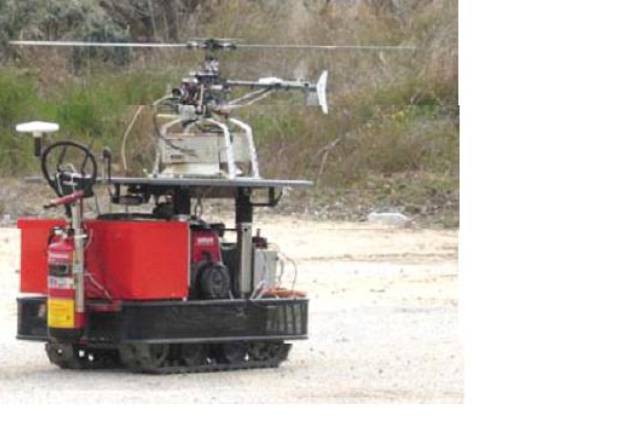ROBOTIC SYSTEM WITH OFF-ROAD CAPACITY AND GYROSTABILIZED PLATFORM FOR COLLABORATION WITH UNMANNED AIR VEHICLES
Description
Search and rescue operations in disaster scenarios pose significant problems for response teams: unfamiliar and unstructured environments, mobility over difficult terrain, duration of operations, detection and handling of victims and dangerous material, or removal of debris, for name just a few. In addition, the difficulty in detecting victims or dangerous material must be added. Thus, the present invention consists of a mobile robot that allows inspection, surveillance, transport and assistance tasks to be carried out in hostile and dangerous environments for man. The robot is based on a vehicle traction by chains with guidance by sliding, which allows it to carry out these tasks in difficult or unknown terrain, such as forest terrain, rocky and sandy terrain, rivers, flooded areas, etc. In addition, this off-road robotic system is capable of collaborating with unmanned aerial vehicles, facilitating their take-off and landing from a gyro-stabilized platform attached to the robotic system itself. On the other hand, the robotic system receives information from the environment through the external sensor system. These sensors collect information about obstacles, surrounding terrain, etc., and send it to the control system. The control system, based on the information received and a previous plan or orders received remotely, generates orders for the locomotion system of the robotic system, always in accordance with the policy determined for the robot team in which it is integrated. At the same time, internal sensors provide information about the status of the robotic system, in the form of data on speed, incline or platform status. The entire set is powered by an electric generator installed on board.
Advantages
Among the advantages of the present invention are: The platform that the system carries can be used as a take-off and landing runway by an aerial robot. This allows such an aerial robot to travel to the vicinity of the area of interest before making its flight, increasing its autonomy. On the other hand, the robot has a very powerful sensory system that could even warn of the detection of dangerous chemical substances, fires, nuclear contamination, etc., which can be remotely monitored.
Uses and Applications
The present invention is suitable for exploration, surveillance and rescue tasks, especially when terrain conditions are adverse.
Keywords
Sectors
Areas
Patent Number
ES2332488
Applicants
Universidad De Málaga
Inventors
Alfonso Jose Garcia Cerezo, Jorge Luis Martinez Rodriguez, Jesus Morales Rodriguez, Antonio Mandow Andaluz, Jesus Manuel Gomez Gabriel, Alejandro Pequeño Boter, Juan Jesus Fernandez Lozano
Filing Date
13/12/2007
Protection Level: National (Spain)
Processing Status: Spanish patent








